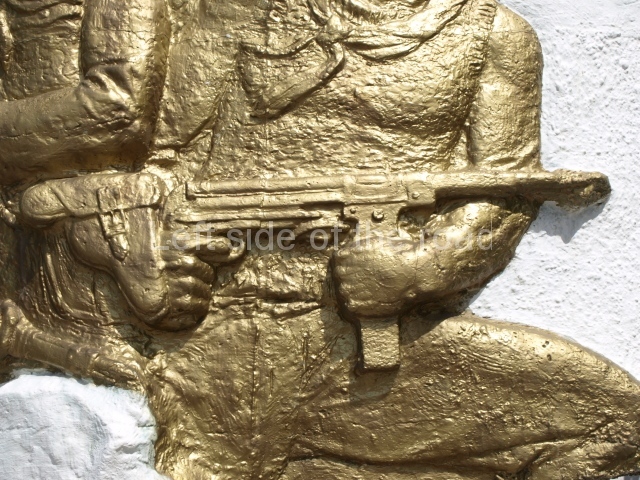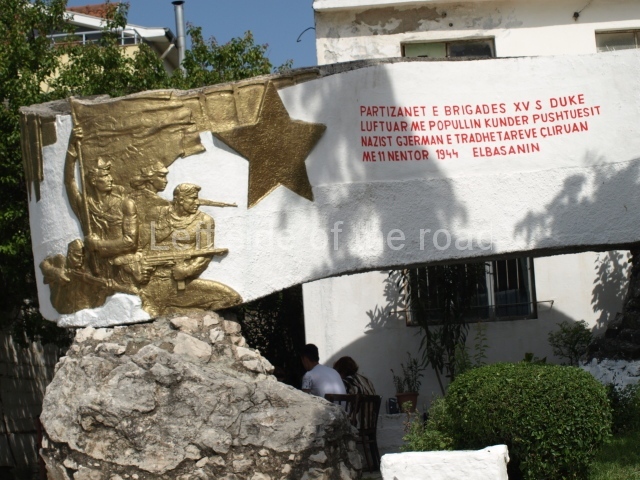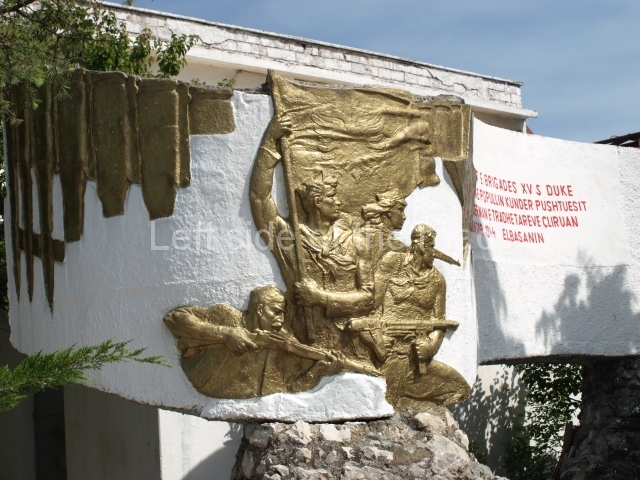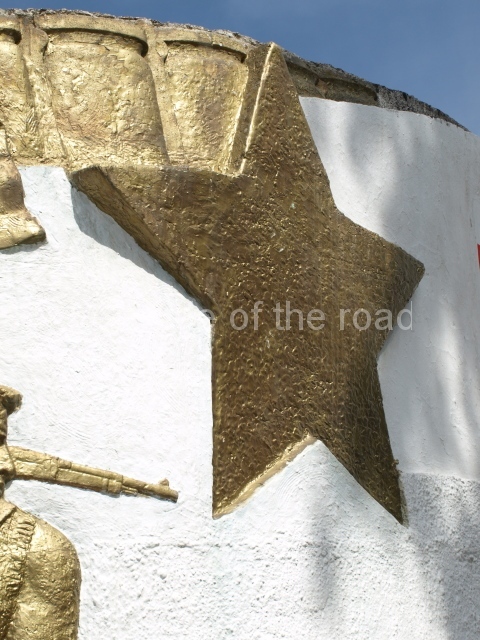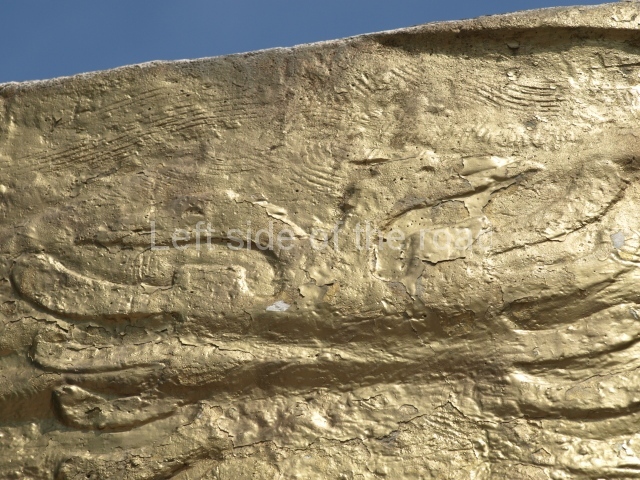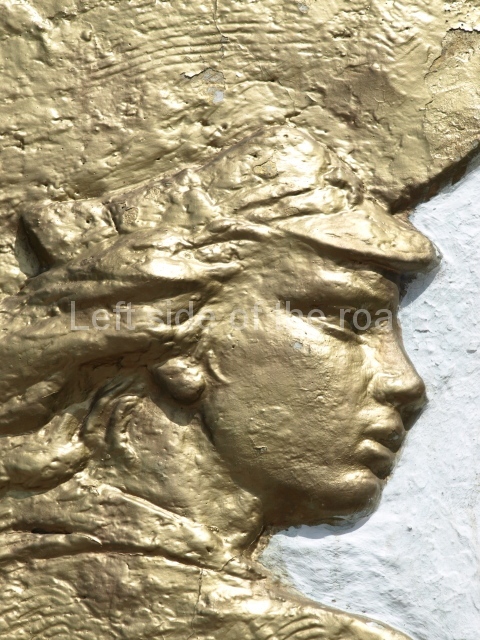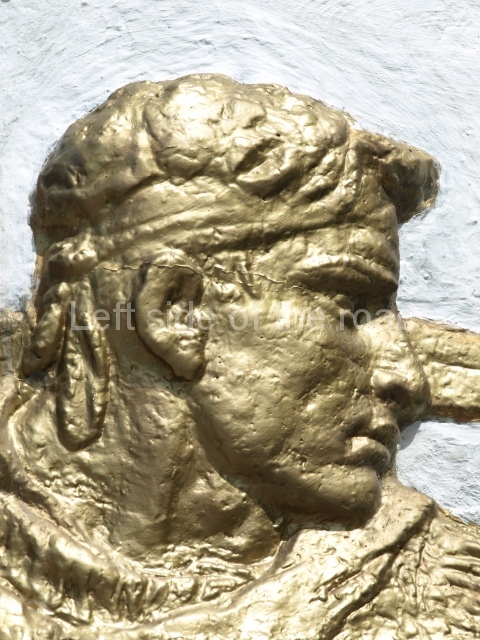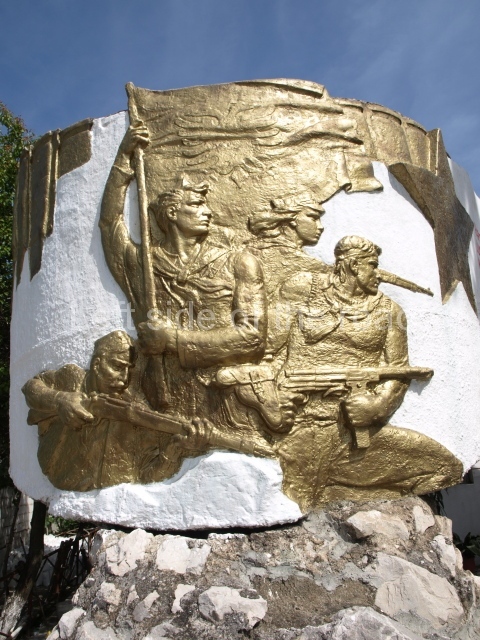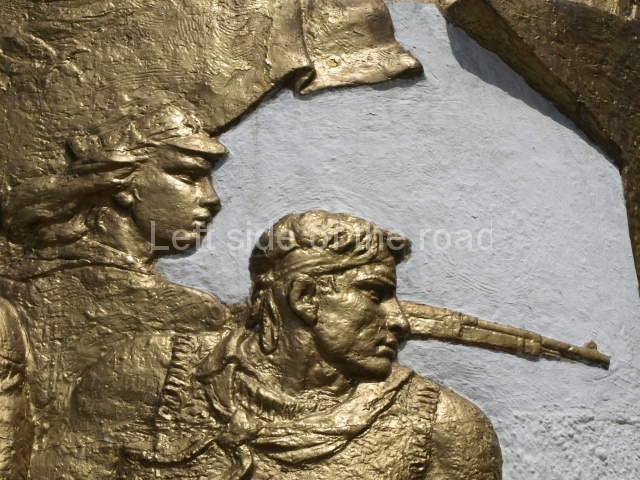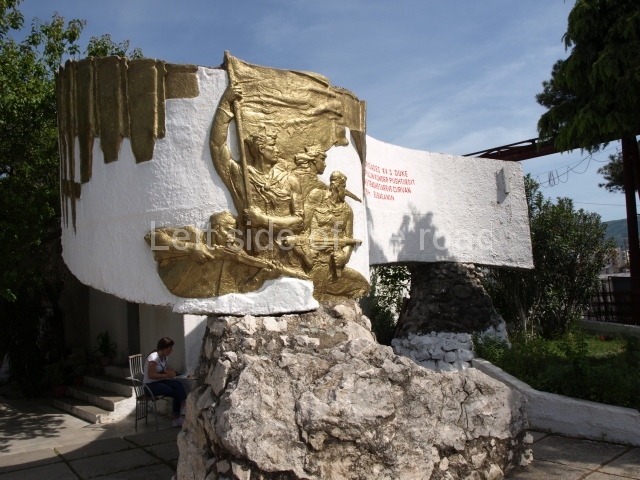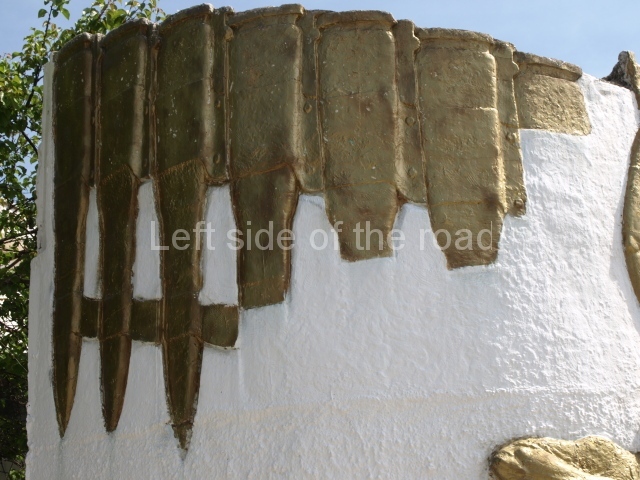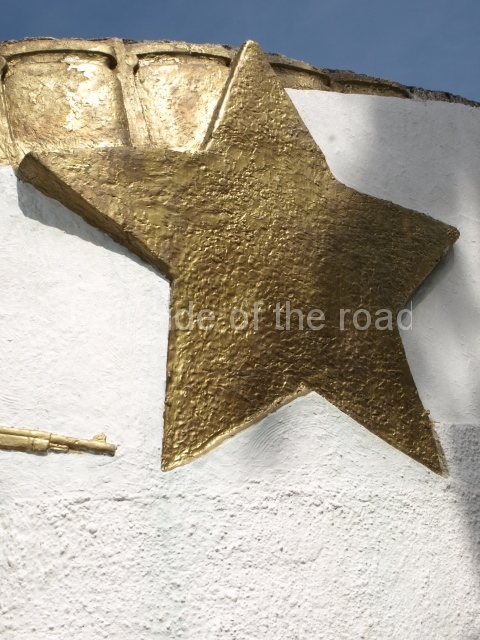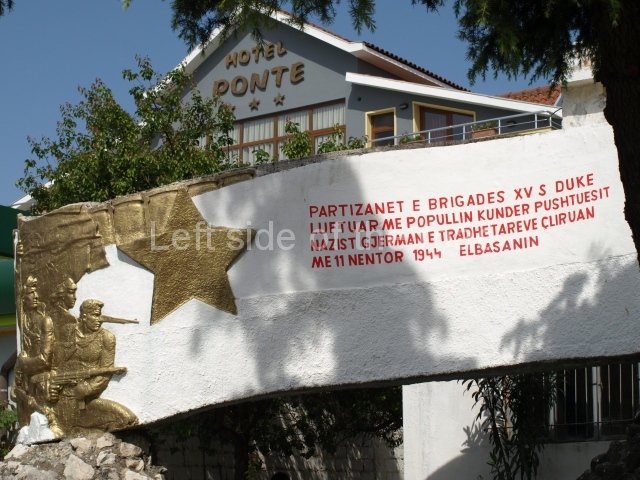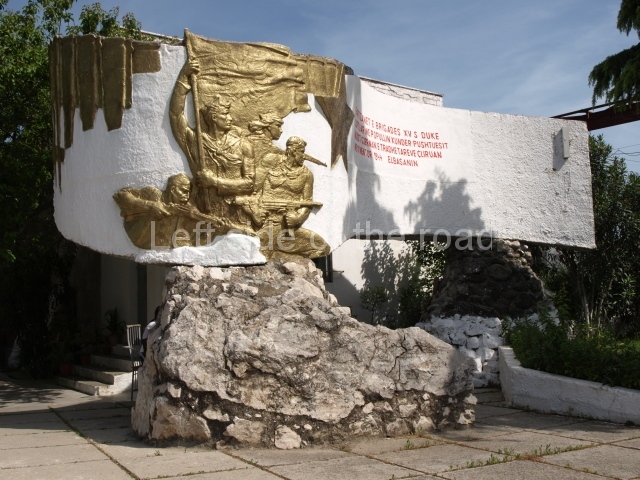
News of the morning – Niko Progri
Ukraine – what you’re not told
This speech of Enver Hoxha from 1965 is reproduced here as part of the collection of material from Albania that relates to the concept of a ‘cultural revolution’ – the struggle of ideas in the construction of Socialism.
LITERATURE AND THE ARTS SHOULD SERVE TO TEMPER PEOPLE WITH CLASS CONSCIOUSNESS FOR THE CONSTRUCTION OF SOCIALISM
The closing speech delivered at the 15th Plenum of the CC of the PLA
[This Plenum discussed the situation of literature and the arts in the PR of Albania and gave orientations for their further development.]
October 26, 1965
Dear comrades,
I was in two minds whether or not to speak at this meeting, and the cause of this hesitation was that the report of the Political Bureau delivered by Comrade Ramiz [Alia], as well as the very good and mobilizing contributions of the comrades have analysed the major problems with which we are concerned today, have examined in an all-sided way and subjected them to a profound Marxist-Leninist analysis.
Hence, in view of what has already been said what I am going to say will not be of any special importance.
However, allow me to re-emphasize some of the ideas that were expressed either in the report or in the discussion.
In one of his writings Marx says:
‘.. we are not going to come out before the world as doctrinaires with a new ready-made creed: here is the truth, fall on your knees before it! We are developing new principles for the world, which we draw from its existing principles. We do not say to the world: ‘Stop the struggle; all struggle is in vain’, we provide it with the true slogan of the struggle. We are simply showing the world the real reasons it is fighting for, whereas consciousness is something that the world has to gain, regardless of whether or not it wants this’.
[K. Marx and F. Engels, Letter from the Deutsch-Französische Jahrbücher to Ruge (1843)’ Works, vol. 1, p. 381, 2nd Russian edition.]
These words of Marx should inspire us also in the development of literature, the arts, and culture in general.
It is not consciousness that determines being but it is being that determines consciousness. Looking at the question from this Marxist-Leninist angle we can understand the magnitude, variety, as well as the difficulties of the leading role of the Party in the tempering of consciousness, of consciousness as a direct derivative of the struggle and the efforts of our people.
From this stems the great role which literature and the arts should play in the inculcation and development of this consciousness, closely linked with the period we are going through, with the efforts, the struggles for the construction of socialism, with the struggle on a world scale against imperialism, the bourgeois ideology and its variant, modern revisionism, etc.
The consciousness of man and that of society is not something petrified, unchanging, formed and developed once and for all. It undergoes positive and negative changes, it alters in accord with the material-economic forces, with the class struggle, the revolutionary situations, the relations between the antagonistic and non-antagonistic classes, with the ideas which inspire the class struggle, the revolution, and so on.
We say ‘class consciousness’, ‘proletarian consciousness’, ‘bourgeois consciousness’, ‘capitalist consciousness’, we say, ‘he has a clear conscience’ or ‘a troubled and heavy conscience’, and so on. This means that in life and struggle people do not display a standard consciousness; consciousness reflects different world outlooks, which derive from the developing economic situation. But there is more to it than this, although, as Engels says, this is the main thing, the decisive thing that opens the way. It is also dependent on other social factors and on the superstructure of every economic system, because, on the basis of dialectical .and historical materialism, the prevailing ideas in one or another country, in one or another historical epoch, are those of the ruling class. Both the feudal class and the bourgeoisie have each tried to proclaim the ‘universality’ of their ideas, to create, to mould the consciousness of their class, in order to prop up and perpetuate their state power. However, at the same time, their economic system, their reactionary ideology, their class consciousness also created their grave-digger – the proletariat, with its proletarian ideology, with its proletarian consciousness, with its social-economic system – socialism, with its science of the vanguard, of revolutions, the class struggle, and with its own ideological and political superstructure.
Socialism has transcended the borders of one single state, the imperialist bourgeois system is heading for its demise, Marxism-Leninism is enlightening, inspiring, and leading mankind to revolution, to socialism and communism.
By going through struggles and revolutions. today our Albania has become a socialist state, where the working class is in power, where our Marxist-Leninist Party is successfully and unfalteringly guiding the future of the people towards socialism and communism.
In such conditions, the tasks of the Party, and those of literature and the arts in particular, in tempering the people with working class consciousness, with the morality of the working class, in order to go ahead successfully with the construction of socialism, are glorious, but by no means simple. If we do not examine the developments taking place in our country from the unerring angle of Marxism-Leninism, as the Party teaches us, if in our analysis and interpretation of these processes we are not guided by the compass of Marxism-Leninism which the Party has put in our hands, not only will we make mistakes in our judgement of things, but the changes and progress will be made more slowly and with greater difficulty.
Albania embarked on the road of the construction of socialism after a long process, after many efforts, revolutions, struggles with the external and internal enemies, a process which has its roots deep in the ancient history of the people: economic processes – economic struggles, political processes – political struggles, processes of ideas – ideological struggles, literary processes – literary-political struggles, etc.
All these processes tempered the Albanian people, armed them to resist the enemies, to fight them, to fight the feudals, the bourgeoisie, reaction, fascism, and finally, to take state power into their own hands. The thinking of our people advanced, their patriotic, political, and moral consciousness was awoken and underwent positive tempering. Herein lies the key to the victories of the Party, herein lies its mastery, in that it knew how to reckon with these things in their revolutionary dynamism and development.
But it would be a mistake to think that after every process and every victory, the past and especially the old world outlook, which is expressed in customs and prejudices, are wiped out at once, completely, and without any danger of their returning. It would be naive to think that the old retrogressive world outlook and prejudices in the consciousness of men, in the mode of working and thinking, in the way of life, would be wiped out automatically, parallel with the economic and political transformations which make the greatest and most rapid strides forward.
Nevertheless, it must be understood correctly that the new revolutionary men have not fallen from the heavens, but have been prepared in the new economic and political conditions. Hence the material basis for such a transformation exists and the ideology of the Party that inspires them also exists. We must push this basis forward and from it we must fight the shortcomings, mistakes, the remnants and impediments from the not-too-distant past, which show up in one way or another in the people’s consciousness and their daily struggle.
Thus, under the leadership of the Party, the energies of the entire people should be mobilized for this struggle, for the new life, for a better, more bountiful and more beautiful life and future.
I want to turn to the concrete reality and to emphasize with what a sacred duty and a heavy burden of responsibility our Party and people have charged you writers, poets, artists, composers, painters, sculptors, etc. Like everyone else, you, too, must carry out these tasks conscientiously, with your struggle and toil. Your valuable and delicate work must be inspired by the Marxist-Leninist ideology, because only in this way and by basing yourselves on the people, on their struggle and efforts, will your militant and revolutionary spirit display itself and burst out in your creative works and activity, and thus you will become educators of the masses who accomplish great works.
The work is extending, the level of the masses is rising, their demands are increasing in quantity, quality and range, therefore the Party and you, all of us, are faced with heavy collective and individual tasks, and we must make great efforts to fulfil them.
If we advance with the people, live and struggle together with them, if we know how to make good and proper use of the numerous material and moral means that the Party and the people’s state power have put at our disposal, the literature and the arts in our country will continue to advance with great and unprecedented vigour. Among the people we should find our inspiration, the notes of the song, the rhythm of the dance, the purity of the language, the tempo of work, the inspiration to creative work, the example of heroism and sacrifice, the lofty virtues of the people’s modesty, of the people’s justice, and so on and so forth. The basis of creative activity in the arts and literature, as in everything else, should be the people.
Whether to build a colossal hydro-power station on a big river to provide the people with light and to make the river irrigate the fields and create prosperity for the people, or to allow it to flow how and where it will, to create ponds and marshes, or to flood the wheat fields, depends on us, on people.
Of course, the Party has followed the former road and has done great things. But it is known that the building of our hydro-power stations, and the draining and irrigation of our land, at one time either marshy or parched, are by no means mere fantasy, nor have they been created by our people merely with dreams and imagination. These people, once ignorant and today learned, have tramped all over the country, have worked and lived in water and mud, with mosquitoes eating them; others have laid down their lives while working to build the dams, just as in our beautiful legends about the building of bridges and castles.
Hence, when the Party advises our people, and particularly the writers and artists, that they must equip themselves with broad culture, must learn Marxism-Leninism, must go to the people and work in their midst, become inspired and create there, this is a decisive issue. The work should be conceived in close connection with the aim and the reality. And this reality is at the base, not within the four walls of your study, nor is it the brainchild of some mountain-top god. The head adapts, harmonizes and beautifies it from every aspect.
There are some who think, and think mistakenly, that by making a flying visit to the base, by sitting in a cafe, cigarette in hand, in order to see the various types whom they want to put in their work passing in the street, or who think that by walking through some factory or plant, they have gathered the necessary material and go home, where they start to write superficially, and sometimes entirely back-to-front, about those things and people that they ‘photographed’ in passing. Thus the world of such a person is restricted by the narrow petty-bourgeois concept of the role of the writer, and he thinks that his head is capable of doing great things. But can it be said that the engineers of the hydro-power stations or those who drain the marshes do not work with their heads, and that the writers alone have this privilege? No! But the engineer, quite correctly, works with the people, studies the environment, the nature, draws plans, checks them again with the people, with the best experience of others, encounters difficulties, struggles with them till he overcomes them. But should not our writer and artist work in this way, too? Then why do we have to point this out to him so many times?
Fortunately, we do not have to point this out to all but there are some to whom it is necessary to mention it. because such individuals not only lack any correct concept of work among the people and with the people, but are the only ones and the very first to make claims for themselves.
Many people have an inclination to be a writer or poet, but not all of them can become writers and poets. To be a writer or a poet does not mean just to have an inclination, to link phrases imaginatively or to create rhyming or non-rhyming verses, it is not sufficient just to have gone through a special school, where you have learned the art and technique of this skill. No! I think that this is not enough.
You cannot become a real writer simply because you have talent, if you do not develop this talent, this means, by learning, if you do not work on it, test it, and hammer it into shape on the great anvil of the people and if you do not study a great deal, and first of all, the social and economic sciences. Only in this way will the writers provide the working class and the peasantry with worthwhile works.
I said that the writers and artists should study science but they may ask, where will we find these scientific works to study? In our country not everything is prepared and ready to hand. Many things are prepared, well or with mistakes, others have to be studied and written, have to be studied even while preparing your novel. There are many facts and documents in existence, not only of our National Liberation War and the construction of socialism but also of pre-Liberation times. However, these have to be searched out, studied and exploited by all, and not by the method of fantasy, but scientifically. You must not say lightly, ‘I have experienced these things, so I know them and do not need to refer to the documents’, or ‘My grandmother told me these things as we sat around the fire-place and I can write about the life of our people in the past from my own imagination’.
Such a work cannot be considered serious. A serious work is one which deals competently, in a scientific way, with all aspects of the particular problem, which carries the problems through to the end, which analyses the process correctly and in a realistic manner, makes it completely understandable, and brings out properly, along with their good and negative aspects, the circumstances that brought this process about, the role of the main operative forces and actors of this process. Then the work becomes vivid, educational, arouses enthusiasm and opens perspectives; the heroes also come out as living people and fight, not with the moon, but with reality, with the difficulties of life.
The range of themes is extremely wide, extremely inspiring to those who want and know how to write and create. The themes are just as numerous, with as great a variety as our life, as the struggle and efforts of our Party and people.
I do not want to repeat anything of what was said in the report delivered by Comrade Ramiz in regard to the range of themes and our objective of tempering the new man of the new socialist Albania, of inspiring him with the heroism of the National Liberation War, with the heroism and the sacrifices of the people and the Party, with the ideas of the partisans, with their aspirations and dreams, in order to inspire and educate him with the rich, exalting, living reality of the construction of socialism in our country, this period which is one of the most brilliant in the history of our people.
Beautiful works have been written about these periods, and an endless series of hundreds of others will be written, which will perpetuate the majestic work of the Party and the people. The main stress should be put here. The men of the new Albania, who under the Party’s leadership, in the course of their work and struggle are performing miracles, should experience this reality intensively, should understand it properly in order to go armed into the coming battles, which will no doubt be difficult. and which will certainly be won by our people.
These two periods are an inexhaustible source for our writers and artists, they are the great base of inspiration, and I shall say no more about this. However, I want to re-emphasize the importance which the past epochs of our people have for our literature and arts. I am thinking, especially, of the romantic epoch of the Renaissance, without going back to ancient history.
The history of our people is an indivisible whole. For purposes of study we may divide it into periods, epochs, on the basis of economic-social development, on the basis of wars and revolutions with arms and pen, etc., but the history of our people is a single whole, and as such it should be made the subject of an all-sided scientific, literary, artistic study by all our people of all fields of creative historical and literary studies, and these should complement one another.
The history of our people must be a subject for study not just by historians, but also by economists, lawyers, philosophers, sociologists, ethnographers, linguists, composers, writers, painters, sculptors, architects, critics in various fields, etc., etc. Without all-sided, detailed, careful work, unearthing every document, every legend, every custom, while studying and interpreting them correctly, in their dialectical materialist development, we are not going to have the literary works we need. These broad fields of the history of our people are not separated by walls, which require that the jurist, for example, should do his work first so that the writer can then take over and base himself on this.
Let us take a concrete example. Suppose I am a writer and have in my head a theme about the pre-Liberation period of Albania. There are two ways I can choose, either to indulge in fantasy, simply relying on what I have heard from my mother or grandmother about the sufferings, struggle and efforts of our people, or to ‘take these things ‘into ‘account while making concrete studies.
Where should I carry out these studies? First, among the people; the people are the greatest book, even greater than grandmother’s; then in the archival documents of the regime of that time. Do they exist? Yes, they do, but they are covered in dust. These documents are the shame of the tyrannical regime of Zog, but there you find reflected the struggle, the grievances, the law court records of our people, you find reflected there the political, economic and social situation, the oppressive measures, the usury, the plunder, the brutality of the regime, etc., etc.
How can a writer fail to make use of them, how can he wait till the jurists carry out and complete their studies? The writer ought to knead the dough with his own hands, otherwise he has chosen the easiest, but least fruitful way. With this I want to bring to our writers’ attention that there is a gap in our pre-Liberation literature for the reasons we know. It falls to us to fill this gap, to cover it with realist works, which will bring out the continuity of the life, the struggle, the work and thinking of the Albanian people even in those dark periods of their existence. If we fail to do this, we shall be making a mistake and the coming generations, who have not lived in that period, will not know the past of our country and people properly, and will not treasure the efforts of our people and Party to mount the difficult steps one by one, as they ought to.
But there is an important question we should always bear in mind, that the emphasis laid on the values of the past of our people should not create even the slightest confusion in the minds of the people of our time of socialism. It is our duty to cleanse the treasures of our national culture of their bad aspects, and these treasures should serve the socialist order we are building. We should bring out very clearly those things which help and not those which hinder the development of our society today. The aim of the Party is to create new values. Our revolution demands new heroes appropriate to the time, the efforts, and the aims of our period. Not all the deeds and attitudes of the heroes of our people’s past are in conformity with the requirements and ideals of the people of our epoch.
There is also another reason. We carried out the revolution, now we are building socialism, but the past, in various forms, is a burden on our backs. In order to combat the negative consequences of the past, we have to explain to the younger generation the origin, the reasons that caused the development of these things. Our fathers and our generation have experienced those situations, but the others have not. However, in this direction the page is not entirely blank. Some valuable novels have been written about pre-Liberation times. The novels of the epoch of socialism, too, can speak about the past. We must not neglect these periods and must enrich our literature and arts.
Literature and the arts reflect the existing social relations. This is true of all periods, from Homer and the Greek society of that time to capitalism, from the Enlighteners to Gorky, Mayakovsky and the Great October Revolution.
Our new literature and arts, national in form and socialist in content, follow this course, too. Many beautiful, realist works have been produced by our people … When you read them, hear them, or see them, you are seeing and feeling the pulse of the life and struggle of our people. The talent of our writers and artists is developing successfully and advancing with their efforts to learn, to study, and to link themselves with the people.
A great inspiration is urging onward a new generation of wonderful writers and artists, who are winning renown and becoming dear to the people. Our Party, through its work and maternal care, must protect, educate and encourage these young people with all its means.
We must encourage the new talents. To do otherwise would be a mistake, but without checking their impetus, we must educate the new talents in a correct way. We must teach them not to become conceited over a couple of poems they have written.
Let me tell you something that happened. Some years ago, in the paper of a house of culture, I read some simple poems by a young girl, a teacher. I said to myself: her verses are not without an idea. I lost sight of her, but some months ago I received a letter from her, the tone of which seemed to me very brash and arrogant in regard of the Publishing. House and the people of education, who do not publish her ‘works’ allegedly because of jealousy, and so on. Well, I thought, youth is -youth, and we can forgive its impetuosity, and I advised the comrades to keep close to her, to make things clear to her and help her. Later I received another letter from her, full of anger and arrogance in regard to our publishing organs. In a word, she is just about demanding that ‘they put up a statue to her’. Such things are not good, but, after all, she is a young girl and we should be indulgent; but I want to tell of another instance, this time about an elderly man, who was in the War and has written some verses to the rifle. They are some three separate poems without any great value; but the Publishing House has published them in a booklet of 8 or 10 pages. Somebody made a serious criticism of it. Apparently this friend considered his poetical ‘rifle’ insulted by this criticism and wrote to the Central Committee that measures should be taken against the critic, who, he claims, made this criticism out of spite. ‘because · – listen! – when he was my student, I gave him a bad mark for his composition!
From these and other examples of this kind if should be understood that to write for the people and publish for the people is one of the most serious and delicate things. Those who write should keep in mind Marx’s idea when he said to Engels:
‘Nothing has been, or ever will be, published from my hand that is not perfect’
But there has been only one Marx.
However, we should feel that when we set about writing for the people we are doing a great service, but the people want us to be modest. We should also understand that the Party and the state have set up the printing houses and the press, not to publish any rubbish somebody chooses to produce, even though he may be an old writer who has produced good stuff in the past, but has now run out of ideas and produces worthless things. Everything should be examined with a critical eye by the critics, the publishing houses and other enterprises, without bias (because, unfortunately, there are cases of bias). The Party and the organs of state power should be vigilant. I am of the opinion that we should not wait for masterpieces to be turned out, and then print; by no means, because we would soon run out; but neither should the press be used by a few people, and fortunately there are not many of them, for their own financial profit, or to spread ideological confusion or valueless works. There are such petty-bourgeois elements, who push themselves into the limelight, who with their ill-formed or petty-bourgeois ideological and political baggage, distort the ideas of the proletariat.
Engels severely criticized Karl Liebknecht for having allowed such people to penetrate into the party and its press. We should not think that we have escaped such unhealthy elements. These we must cure in a correct way and not by patting them on the back.
Marx said,
‘Of course, the writer must earn money to live and write, but in no instance should he live and write to earn money.’
[K. Marx and F. Engels,1842, Collected Works Volume 1, London: Lawrence & Wishart, 1975, pp. 174-175]
And we should not think that we have escaped these unhealthy elements, either. These, too, we must cure and teach how to go straight.
The Party’s policy in the field of art and literature has been and is clear to everybody. It will always give powerful support to the good works, the correctly inspired works, those that educate, mobilize and open perspectives. Mistakes are made and will be made, as happens with every work. They should be corrected; criticism should be constructive and not denigrating, and he who is criticized should respond, not with petty-bourgeois pride, which keeps all its sins to itself, but with an open heart.
With those who are confused in their works from the ideological, political and artistic point of view, in content or in form, it is the duty of the Party to correct them with patience. I agree with the criticisms, which were made in a correct spirit and with good aims, about two or three plays and some works of prose or poetry. I know that their authors have honestly admitted their mistakes and I am sure that they will not repeat them. I am convinced of this because they are sons of the Party, in whom the Party has confidence, because they are talented writers, determined to serve their people on the road of the construction of socialist society and socialist culture, and their mistakes can be considered momentary ones. The Party will look after them, will extend its hand to them, as always.
But when it happens that it pleases someone to produce mistaken things, in bad taste, which nobody needs, he has no reason to complain about the Party; it will neither publish nor sell them. Let whoever so desires go on producing for his own bookshelf, and we shall not disturb him so long as he does not become socially dangerous.
In regard to literature and the arts which are developing in our country, as in regard to the other issues, there are not two moralities, but only one, the proletarian morality of the working class. The ideas expressed in the works should conform to this morality. A work devoid of ideas and of this morality may occasionally appear to be of some limited interest from the viewpoint of its artistic skill, but from the social ideological viewpoint it cannot have any value. Therefore we should always bear in mind that the maintenance of a stand in literature and the arts is part of the political struggle waged by our Marxist-Leninist Party, in complete unity of thought and action with its people.
In the report and the discussion of it, there were many correct things said about folk music and folklore. I am not going to enlarge on these important problems and the principles guiding us in our work, but I shall underline some ideas.
Folklore should not be identified narrowly with folk music. Folklore is not only folk music; music is only one of the expressions or manifestations of folklore. Folklore covers a very wide range, as wide as the life of the people. Folklore is the song, the lahuta [a kind of lute], the pipe, the drum, the folk songs of Laberia, Myzeqe, Devoll, Dibra, Shkodra, etc. On the other hand, neither the popular satire, verse, or fables, nor the weddings, mournings, joys, or sorrows, nor the multi-coloured costumes with all their variations in cut and style, the popular handicraft with its national flavour, can be divorced from folklore, any more than the customs, the written and unwritten laws, etc., etc. can be divorced from it. In my opinion, if we fail to understand the problem in this way, if we destroy its basis, do what we may to preserve our folk music, we shall not achieve this. In order to preserve our folk music, the basis for it, or the main parts of this basis, must be preserved. The improvement of folk music should proceed parallel with the improvement of the basis for it.
To put it more concretely. We know how all our great folklore has been developed and enriched. Whole books should begin to be written about it, for this is a priceless asset. We have set up a Folklore Institute and think that everything has been done. The Institute is working, but rarely does anyone go there to make a thorough study of those valuable things it has collected, not to mention the music and art schools, whose programs, if I am not mistaken, deal very little with our folklore but almost entirely with classical and modern music.
What occurs in the majority of cases? The banal verses of some poets, to whom an article of the ‘Zeri i popullit’ gave a well-deserved thrashing, are preferred by our musicians and around them they compose their music. If some one were to tell these musicians to have a look at the popular verses of Uncle Selim from Brataj [a singer of folk rhapsodies], they might smile ironically and even deride him, saying: ‘He is not in his senses’. But the people themselves have put the verses of the Uncle Selims to music and have been singing them for centuries, those verses which you ‘boast about’ in principle, but which you scorn in reality. There is inconsistency here, you say one thing and do another. With this I do not mean that you should not write beautiful new verses and set them to music.
Let us take the question of musical instruments. On the one hand there is talk about the beauty, the variety of folk music, on the other the houses of culture are filled with accordions, guitars, mandolins, whereas you will find few of the pipes, clarinets, tambourines, drums, lahutas, bagpipes etc. with which the people have sung and which are a great foundation for our folk music in the houses of culture, and especially among the people. I am not in the least against new instruments and the best of the new music. On the contrary, but I am also for the old instruments, for producing and spreading them among the people because through the centuries the people have sung with them about their joys and sorrows, the struggle they have waged, and they want to sing with them and will continue to do so.
Such an incorrect action has brought its own consequences. The new instruments have spread the modern songs, to, which I am not opposed, but willy-nilly, there is a danger. that they will gradually take the place of the folk songs, and this would be a great mistake. They have led to the spreading of European dances, to which I am not opposed if they are kept in proportion, but we must not eliminate the folk dances, because this, too, would be a great mistake. We teach the people who graduate from the schools, whom we send to the houses and centres of culture, to organize modern choirs and a number of standard things, but they are not taught to inspire the workers to sing folk songs, either when they are alone, or when they are at work, to put their heads together and sing in pairs, as is the custom with our people. Indeed they forget that the people love to sing, that they do sing, because their life, their traditions and customs demand it.
The folk songs and dances go well and in unity with the jokes, the marvellous humour and the costumes. But, little by little, we are eliminating them; forgetting the jokes and popular humour, displaying these costumes in museums, and what is worse, we are doing this in an administrative way, through orders and campaigns (I am not referring to either the baggy Turkish trousers, which are not national and should be put away in museums or at the bottom of clothes chests, or the ugly woollen breeches worn by women in some districts).
The Party has been right to say that money should not be spent uselessly on folk costumes, that people should go to work in plain clothes. But what harm does it do us if a girl wishes to dress in a beautiful national costume when she marries, or a man from Dibra wants to wear a pair o.f the traditional trousers? This does no harm; on the contrary, it is all to the good, because it helps preserve our traditions. We are not ashamed of our national costumes. On the contrary we are proud of them, and they are beautiful. But he will spend a lot of money, they say. That is his business. Let him reckon up his own budget. After all, why should we interfere?
The Party’s advice is that there should not be great useless expenditure on funerals, weddings, dowries and other such manifestations of life. This instruction is correct, but in many cases it is understood and applied wrongly. One may ask, what connection has this with folklore? It has a great deal to do with it, because our folklore and our customs have been developed and enriched during these important events in the life of men. There are also some bad customs that come under this heading, and the Party has issued instructions that they must be eliminated, but not to prohibit the fine customs of the people. To advise someone not to involve himself in heavy expenditure when his son gets married is correct, but to instruct him how many people to invite, or advise him not to invite some friends and relatives to sing, dance and enjoy themselves is a mistake. To combat the idea of a dowry for a daughter, as it was understood and practised in the past, is absolutely right, and this fight must be continued, but it is wrong to prohibit a parent from seeing to it that his daughter has some clothes, a bed, and some other things. But in this latter instance, when such a fuss is made about these things that every girl feels she has to bring her husband a dowry, or otherwise he will not marry her, as actually occurred in an ugly incident in Korea, this must be combated.
But how can we fight these evils among the many fine customs of our people? With administrative measures? No! They must be fought through educative work, good examples and well-considered actions towards various manifestations in life. These evils can be combated through our manysided folklore itself. The people have a great deal of humour in their songs, they make many pointed and witty jokes which make you laugh, but educate you, too. The variety shows can do a great deal in this direction …
The institutions and the works they perform must be of the people and for the people, express the struggle of the people for the construction of socialism, their finest and purest sentiments and aspirations, must follow the efforts of the people step by step, inspire them correctly, open up new perspectives and be in the vanguard.
If our institutions are to achieve this, the authors and actors must live with the people and with the line of the Party, must know and feel the problems of the people, their joys and sorrows, their victories and defeats. This reality can be neither written nor expressed on the stage on the basis of formal lessons alone. The school teaches actors, musicians, etc. a great deal, but life, with its toil and struggle, teaches them other, very valuable and inspiring things. The play, the author, the director give the actors their instructions, but neither the author nor the best director can teach them what the life of the people, their feelings and experience teach them. Life and the revolutionary struggle full of the vigour and enthusiasm of the people and the Party are the most talented authors and directors there can be.
However talented the artists and the writers may be, I would never use the bourgeois term ‘stars’. No, compared with the talent and the creative skill of our people they can never be ‘stars’. Therefore, if these ‘stars’ – lose contact with the earth, they lose all their brilliance.
The repertoires of our opera and ballet theatres should be simple and understandable to the people. This does not mean that they should be ‘banal and devoid of ideas’.
In a simple presentation the ideas are expressed more clearly and fluently, like the clear waters of a mountain stream.
A complicated, intricate and exaggerated presentation, in most cases, hides unclear, equivocal ideas.
The people need clear ideas, not obscure ones, therefore, the Party will support the former and not the latter.
In our musical and theatrical works the people should be presented in struggle and in work, just as they are, with their noble sentiments, their heroic character, their modesty, their fine qualities and their shortcomings, and these shortcomings should be pointed out because they must be corrected, but they should not be presented for purposes of denigration or disparagement or for the sake of some evil decadent, revisionist theories, by means of which a few aesthetes do not fail to brag and beat the air in order to show how learned, profound and talented they are or in what an allegedly independent spirit they go about their creative work.
To imagine, invent, to conjure up, even with the greatest skill, non-existent situations, unreal characters and types, out of a possibly fertile though unhealthy imagination inspired either by excessive reading of foreign dramatists, without any sort of critical attitude or Marxist-Leninist dialectical method, or by pseudo-progressive, or Freudian philosophical trends, are things which our people do not like, which the Party will not permit and will combat as harmful to the people’s culture.
The wrong outlook of some authors that ‘everything they write should be put on the stage without delay’, should be rejected. The good ones will certainly be put on the stage, while the rotten ones will be thrown into the waste paper basket. Spiritual food is far more delicate than physical food; that is to say, good, fresh meat is eaten, stinking meat is thrown out.
The theatre, the ballet, the variety shows, the opera cannot be at the service of those who are sick in the head, but of those whose heads are in order and whose hearts beat in unison with the heart of the people.
The overwhelming majority of the repertoires should comprise popular, revolutionary, Marxist-Leninist Albanian subjects. Foreign pieces should be somewhat less and be subjected to the most careful selection, not on account of xenophobia, because we know that xenophobia will undoubtedly lead to self-isolation and conceit.
In no way should we cut ourselves off from the best of the world repertoire, but however good it may be, it cannot be understood except by a limited section of intellectuals of extensive culture. The masses do not understand it properly and do not enjoy it, or else we make them dream outside their objective reality, if during the performance, a critical dialectical attitude is not maintained and the stress is not put on its positive aspects.
Some may say, ‘But we must make our people acquainted with foreign reality and the finest foreign creative works, too.’ This is indispensable. I am in complete agreement and do not reject this idea. Therefore I say that our people should be given a taste of this healthy dish, but it should be only one among many healthy and delicious dishes from the Albanian cuisine.
Some may say, ‘But we have no repertoires’. What reasoning! We must create them! At first, they will not be perfect, but that is something everyone has gone through.
If we proceed from the idea of staging foreign ballets, because we have none of our own, and sometimes stage unsuitable ones, we have solved nothing but have created a grave situation. Such an idea is incorrect, is not realistic, because our composers have produced truly beautiful, praise-worthy national operas, our ballet masters have staged choreographic works with folk motifs over which one can enthuse, our soloists sing folk songs and songs of the war that fill one with joy and inspiration and the authors of novels, plays or film scripts have produced works of great value to the people.
Therefore, in order to create something good, which will serve the people and the Party in this great battle for socialism, we must not choose the easiest way, but the most arduous, full of toil and struggle.
I have said already that we may also stage foreign works; possibly our authors, too, will be inspired by foreign subjects, but only in the right way. Always, before commencing work on any undertaking, they must ask themselves the question, ‘Does this thing I am doing serve the great cause of the people?’ One’s fantasy, imagination, ought to work, but not in order to create fantastic things.
I will give two examples of a differentiated choice of compositions:
Some weeks ago, my friend, the well-known composer Kristo Kono, sent me his new composition ‘Prometheus’. He had told me about this opera in a talk I had with him on music and compositions. I wished Kono success in composing his opera even though it was a subject that many well-known composers have tackled. But since he had started work on it. and since I. for my part, consider this theme positive, as I shall explain in a minute, I made some suggestions to him. Kono’s composition may be beautiful, and this is what we hope, and then we shall say that his efforts have not been wasted, because, as you know, Aeschylus made Prometheus, the hero of mythology, a symbol of the fighter for the happiness of mankind. Whoever has read ‘Prometheus’ will remember the words of the hero to Hermes, the servant of the gods:
‘Be sure, I would never want to exchange my miserable fate for your servitude, because I would rather be, bound with chains to this rock than be the obedient lackey of Zeus …
In a word, I hate all the gods’.”
Aeschylus, Tragedies, ‘Prometheus Bound’, p. 71, Tirana,. 1950 (Alb. ed.).
Marx said:
‘Prometheus is the noblest saint and martyr in the philosophical calendar.’
[The Difference Between the Democritean and Epicurean Philosophy of Nature (1841), K. Marx and F. Engels, Collected Works Volume 1, pp25-108]
However, I told Kono that in the history of our people there are many heroic subjects which ought to inspire him, therefore instead of going back to mythology, he should compose something beautiful and purely Albanian, beautiful and inspiring not only to our own people, but also to people outside the borders of Albania. He gave me his word and I believe that he will keep it.
On the other hand, some days ago I read in the paper that our ballet ensemble, in preparing performances for the people, had not found any subject other than Strauss waltzes, arranged in a special composition, allegedly with a theme of proletarian morality, that has nothing to do with the crazy epoch of these waltzes. What are the Strauss waltzes? An excitant, the expression of an epoch, a symptom of the transformation of the society existing at the end of the 19th century. This coincides with the decline of a regime of unrestrained luxury for the bourgeoisie, an epoch of pleasure-seeking, and which is always a disturbed epoch – the ‘Blue Danube’ is not blue, but turbid if we analyse the social and political situation of the time when that waltz was composed. But the music is beautiful. This is an undeniable fact, and I am not against putting this and other waltzes on the radio, but for our producers, together with the ballet ensemble; to work for months on end to elaborate a performance with these waltzes, this is of no benefit politically in the education of the masses. hence is useless effort.
Why do our people need this ballet? What inspiration does it bring them? None at all, I would say.
On this occasion, we must face the question of how we should study and utilize the experience of the foreign world in the fields of literature and music, the fine arts, theatre and cinematography.
Should we profit from world experience in these directions? It would not be Marxist if we were to say no, but it would also be anti-Marxist if we were to become slaves to it and gulp down everything the foreigners have produced, without a thorough critical analysis and a proper classification.
Every work, of every genre and period, has its good .aspects and also has its bad ones. We must choose what is good. Each of these good aspects has its own technique, ideas, art of expression, sound, etc. But should we take these and adopt them en bloc, with the passion and feelings that do not recognize reason, that. do not recognize the epoch, the social situation, the ideas, tastes, and inclinations of people and their struggle and efforts? This, of course, would be a great and very dangerous absurdity.
Every creative work, in whatever epoch, has been tendentiously inspired by the ideas of the time, by the social situation of that epoch. Many works have resisted the passage of time, have foreseen the future, prepared it, but they cannot be considered perfect in their entirety and models for every period, for every epoch. There are people who are passionately devoted to certain of their idols and who, with non-Marxist judgement, seek to introduce these idols everywhere, to adopt them for every period, to copy them in place and out of place, to dress them up in some garments of our time and pass them off as socialist works.
Writers, poets, composers. etc., must read, study and learn from the others. It has never been said that they should not be passionately fond of some of them. but what they learn and study from foreigners should always be taken with a critical spirit and with a definite aim, and what is taken should serve their own people should serve the creators of literature and the arts so that they live with their own people, with their struggles, aims, aspirations and customs in order to create what is suitable and understandable to their people, appropriate to the time and the struggle they are waging. In this way, they will write really original works.
Thus, study of the works of foreigners must serve the acquiring of knowledge of the life, struggle and development of those peoples. This does not mean that the struggle, ideas and development of your own people are the same as theirs. in spite of the fact that there may be some similarities or connections with those of others. This lesson, this experience from the foreign works must see you to open horizons in order to study the history of your own people better but your people’s history has its own peculiarities, your people’s ideas have their particular development in the particular social situation of your people. This interests us, in the first place, and it has also interested that foreign writer of genius, Balzac, when he wrote his great work ‘The Human Comedy’.
We should learn their art of writing, their style, their method of work, rhythms and metre, but we should learn them not to become slaves to them, because our people have their own style and rhythms, we are creating our socialist style which is our basis, on which we shall work, build and create our own originality, for only in such a way will our people understand us and will we inspire them.
I think that we should not step beyond these correct, objective limits, because, notwithstanding the fact that you may be very knowledgeable and learned, wisdom and learning are worthless as long as you do not know how to channel them in the interests of the people; as long as the purpose of them is not to enrich the treasury of the people’s marvellous creativeness, they will be only an ornament hanging from your personal neck, but an ornament of no value to the people …
Some of my conclusions in this closing speech may seem rather blunt. This is not unintentional, first of all, because the conclusions in the report are complete and your contributions to the discussion supplemented them, and second, because I want to stress that in all our activity we must not forget the existing situation of the imperialist-revisionist encirclement of our Homeland and that this encirclement is an iron one and not merely a figure of speech. The bourgeois and revisionist ideology is attacking us from all sides. Our enemies and the enemies of Marxism-Leninism would like us to occupy ourselves with weighing up details on a set of ‘gold scales’ and entering into academic discussions while we let the wolf into the sheep fold. We must shut the door to the wolf and shoot it dead. Let them call us savage, because we play the pipe, and the beat of the drum and the clarinet ring out from our stage, or because we have given the place of honour to dances in our national costumes. For us, the only important thing is to defend the Homeland, the people, Marxism-Leninism and socialism. And these are defended when everything national in form and socialist in content is defended, when the line of the Party is always borne in mind and properly applied.
To you, the people of literature and the arts, worthy sons and daughters of our Party and people, as in the time of the War, the Central Committee directs the call: always hold high the banner of the Party, and always march into battle and to victories with the fire of the Party and the people in your hearts!








